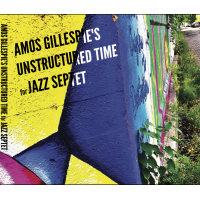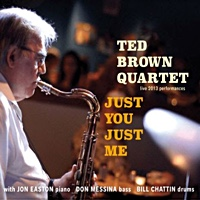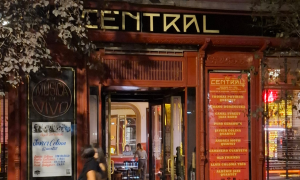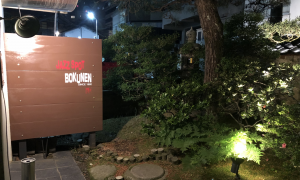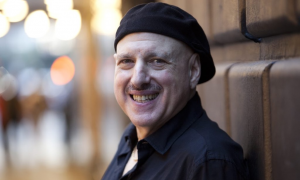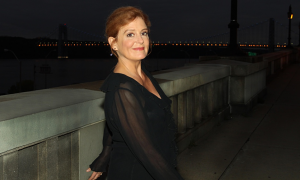Home » Jazz Articles » The Jazz Life » Fit As A Fiddle: How The Violin Helped Shape Jazz, Part 1
Fit As A Fiddle: How The Violin Helped Shape Jazz, Part 1

The early jazz bands, if you look at pictures of them, were string bands largely. You know, there was a violin and a banjo and then maybe a tuba covering the bass part. And gradually, the violin got edged out as the bands got louder.
—Rob Thomas
That was then...
Considering jazz is an art form that mostly makes it up as it goes along, it's ironically appropriate that printed records—i.e., data—from the days of its birth are decidedly sparse. We know, at least, that during the 18th and 19th Centuries in New Orleans white plantation owners, one afternoon a week, allowed their African slaves time off to play their music and dance together. This music, direct from Africa, albeit sometimes via the Caribbean, could be heard every Sunday in the polyrhythmic assortment of drums that accompanied the violins, guitars, hand bells, and banjos of Congo Square, just off North Rampart Street. Congo Square was shut down around 1851. Jazz master Wynton Marsalis is widely reported to have said, "Every strand of American Music comes directly from Congo Square." And it was from this hot house of music, which continued to evolve post-Civil War, that the violin emerged at the turn of the 20th Century as an instrument that helped to shape the birth and growth of jazz.A bold statement it's true, but here's the story:
By the early 1900s in New Orleans, sweaty, high stepping dancers were doing the Cakewalk and the One Step, energized by, among others, the rough and tumble ragtime swing of Buddy Bolden's band. It was said when he played you could hear his cornet two miles away. He was the Charlie Parker of his time. To underscore how popular the music and the band was becoming, one of Bolden's most popular tunes was an original called "Funky Butt," which refers to a bunch of sweaty dancers on a crowded dance floor.
The young, well-dressed Black man staring out at you in this picture, taken in 1909 likely just before a gig in one of the smoke-filled bars and dance halls of New Orleans, was arguably one of the most important people to help jazz become an American obsession. Almost certainly you will never have heard of him. His name was Jimmy Palao.
And he was a jazz violin player.
Regina Carter, one of the giants of modern jazz violin, has made a study of the African roots of jazz violin. In a conversation with her, she pointed out "jazz" can be a loaded word. Talking about those early days in Congo Square, she said, "Well, people don't necessarily think of that as jazz. The music there was basically early African-American music—Black music. And [the violin] is one of those instruments, you can trace its history. But when people start thinking of jazz, they start thinking of some of the rhythms and the chords, if you will. That's why they start with New Orleans [brass bands]."
But in Jimmy Palao's case, despite dying fairly young, he was arguably one of the most successful of the freshman group of musicians who collectively birthed the jazz age, the most famous of whom is Buddy Bolden. Out of sight, out of mind they say. Most of these musicians, like Bolden and Palao, were barely or never recorded and not much photographed either.
In 1900 or thereabouts, Palao was 21 and living in New Orleans just as syncopated music was becoming popular. He was also a close friend of Buddy Bolden. Palao led his own band that played in the dance halls and brothels of the Big Easy, but during the day he traveled the countryside around New Orleans teaching musicians how to read music. One of his pupils was Buddy Bolden. Palao went on to play in Bolden's band and there the student became the teacher— Palao learned from Bolden how to improvise in the New Orleans style.
Rob Thomas, who JazzTimes has called "a violinist of exceptional creative resources," and who is also a professor at Berklee College of Music in Boston, said that "the early jazz bands, if you look at pictures of them, were string bands largely. You know, there was a violin and a banjo and then maybe a tuba covering the bass part. And gradually, the violin got edged out as the bands got louder."
In 1907, Bolden was institutionalized after attacking his mother in the midst of what was likely a nervous breakdown. Whether brought on by alcoholism, schizophrenia, or some other health crisis is not known. A year later, Palao described himself as the leader of The Original Creole Band playing music he called jaz, spelled with one "z." In fact, the first known use of the word jaz[z] is on Palao's business card.
He is likely the first musician to use that word professionally. The group was renamed The Original Creole Orchestra, and by 1911 Palao had brought jaz[z], or at least a vaudeville version of it, first to LA, and then to Chicago. There, audiences at the Grand Theatre on State Street gave them a raucous first-night welcome. From then on, the audiences just seemed to get bigger and more enthusiastic. Palao's was the first jazz band to go on the road in North America, and he toured for years. In some ways, he was a musical Billy Sunday (the powerful Christian evangelist), bringing "the word" of jazz and preaching its entertaining gospel nightly to audiences eager to listen.
Soon, Palao's "jaz[z]" and New Orleans became synonymous, largely because of Palao's touring and the recordings being released by other musicians. His bassist, Bill Johnson, was the band's manager and for the next few years, as WWI raged in Europe, the band was a popular feature on the vaudeville circuit. They played great music, they sang, they danced, they put on a show. In the process, as their music became increasingly popular, they became the first of what would be called "territory bands." The Original Creole Orchestra traveled to more than 75 cities in the U.S. and Canada, getting local and national attention wherever they went, until the group disbanded in 1918.
The group never recorded. However, Johnson booked a gig in Chicago for the band just before it broke up, so he called King Oliver, who traveled up with a couple of musician friends. They joined Palao and Johnson, played the gig, and then started touring together. Palao and his family eventually moved to Chicago around 1924, but later that year, while on tour with Dave and Tessie—a song and dance act—tuberculosis forced him to quit and return to Chicago. He died on January 8, 1925.
As Rob Thomas explained, the problem for jazz violinists was that no-one could easily hear them over the trumpets, tubas and bass saxophones, banjos and drums. A number of fiddlers discovered a strange looking hybrid instrument, invented in 1899 by an engineer named Stroh. The Stroh violin looks a bit like a modern electric violin except for a large trumpet-like bell that protrudes from it at a 45 degree angle that was a crude amplifier. It was kind of ugly, in a "you're special" sort of way, but it was loud, particular when it came to recording, though it was never widely adopted.
While the violin was losing its place as a staple frontline instrument, it still popped up in unexpected places, like Duke Ellington's band when trumpeter Ray Nance—a classically trained musician—would be featured doubling on it. Nance was also a vocalist and a dancer and was nicknamed "Floorshow" by his bandmates because of all the things he could do so well.
Jazz violin became the Rodney Dangerfield of jazz—the instrument just didn't get enough respect, mainly because no one could hear it properly in a dance band setting. With a couple of notable exceptions I'll mention in a moment, in the burgeoning jazz world it was considered a novelty instrument, like watching a bear dance, because the jazz mainstream had almost obnoxiously moved away from its string band beginnings. For quite a few listeners, and musicians even now, jazz violin is only a couple of notches of seriousness above Rufus Harley playing jazz bagpipes. (You got to play jazz however the spirit moves you, though.)
Some of the greatest classical violinists of the 20th Century were born in its first decade, along with four of early jazz's greatest violinists: Joe Venuti, Eddie South, Stuff Smith and Stephane Grappelli. From the beginnings of jazz, the violin was a quietly aggressive frontline instrument, often blended with the clarinet or cornet, so in rare recordings of the time you sometimes have to listen hard to hear it. By the mid-1920s, jazz had started to bifurcate into the "brass bands," bands usually featuring trumpet, cornet, or clarinet as lead instruments (e.g., Louis Armstrong's seminal 1925/26 Hot Five recordings), and the "string bands," predominantly the pioneering duo and quartet records of Joe Venuti and Eddie Lang.
Born in Philadelphia of Italian immigrant parents, in or around 1903, Venuti is considered the father of jazz violin. Venuti relished Marx Brothers- like anarchic humor and was a legendary practical joker. In one account, recounted in the Guinness Encyclopedia of Popular Music, he was said to have filled a tuba player's horn with flour during a break in a rehearsal.
Venuti deliberately gave out conflicting information about his early life. In a 1978 Village Voice piece, jazz critic Gary Giddins said, "depending on which reference book you consult, Venuti's age when he died in 1978 was eighty-four, eighty-two, eighty, seventy-five, seventy-four, or seventy-two. Venuti, who surely had one of the strangest senses of humor in music history, encouraged the confusion... The deception has been variously traced to Venuti's father, who hoped to speed up the naturalization process, to Joe's fear that a foreign-born jazz musician would not be taken seriously by his peers, and to his general penchant for mayhem."
Gene Lees in Waiting For Dizzy: Fourteen Jazz Portraits (Cooper Square Press, 2000), says that when Venuti was 10 years old, while playing violin in the James Campbell School Orchestra in Philly, he became friends with Salvatore Massaro, who was playing next to him in the violin section. The friends were soon experimenting with jazz and blues, as well as playing classical music. Venuti turned professional in 1924, and he and Massaro, who had changed his name to Eddie Lang and was now playing guitar, met up again in New York City in 1925. The two musicians became so well known for their "hot" violin and guitar playing that they were specifically hired to record 12 or 24-bar duets at the end of stock dance arrangements. It wasn't until 1926 that the two of them started recording their trailblazing duets.
As they say in London, they "swing like the clappers," and they are the furthest thing from corny. Yes, it may take a modern ear a few minutes to adjust to the style, but soon enough the musicianship and inventiveness just impress the hell out of you if you have ears enough to hear. Eddie Lang's rhythm guitar predates Freddie Green, (Count Basie's towering, long time rhythm guitarist) and is more extroverted and up front rhythmically. Joe's playing sometimes has that slight Country accent of the time, but his improvisations are great illustrations of the kind of playing that Bix Beiderbecke, Louis Armstrong, and later Lester Young and Roy Eldridge were doing. Lang died in 1933, aged 30, from blood loss during tonsillectomy surgery in Manhattan. The Venuti-Lang recordings were rumored to be the inspiration for Django Reinhardt and Stephane Grapelli's Hot Club de France.
Eddie South was more or less a contemporary of Venuti's. He graduated from the Chicago Music College as a classical violinist, but started playing jazz after he was cold shouldered in the classical world because he was Black. When he replaced Venuti in Paul Whiteman's Orchestra, he had to play behind a screen so no one could see what color he was. An excellent jazz violinist, born in 1904, he died in 1962, but was overshadowed by Stuff Smith.
Grappelli, on the other hand, was a largely self-taught player famous for his partnership with the gypsy acoustic guitarist Django Reinhardt, though his 60-year career went well beyond Django's. He is possibly the most famous and recognizable name when it comes to jazz violin. He had an almost Dickensian childhood in a Catholic orphanage in Paris. His mother had died when he was young, and his dad was conscripted into the army. Grappelli said, "We slept on the floor, and often were without food. There were many times when I had to fight for a crust of bread," Michael Dregni quotes him as saying in Django: The Life and Music of a Gypsy Legend (Oxford University Press, 2004).
Grappelli first picked up the violin at age 12, and eventually took some lessons at the Conservatoire de Paris, but he preferred learning on his own. "My first lessons were in the streets," Grappelli said (according to Dregni), "watching how other violinists played. . . The first violinist that I saw play was at the Barbès métro station, sheltered under the overhead metro tracks. When I asked how one should play, he exploded in laughter. I left, completely humiliated with my violin under my arm."
By 1923, age 15, he was busking in the courtyards and streets of Paris to earn a living. "It was a time when people weren't listening to the radio so much and so had their windows open a lot more," he said in an interview with guitarist Martin Taylor, his long-time collaborator after Django.
Grappelli was spotted in the street by a musician who invited him to accompany silent films in the pit orchestra at the Théâtre Gaumont. They played six hours a day, and during his breaks Grappelli would visit a nearby brasserie, where he listened to popular American songs on an early jukebox. In 1928, 20 year-old Grappelli first heard Joe Venuti with Paul Whiteman's visiting band. His technique, and a solo he played on "Dinah" was all it took to convince Grappelli that's how he wanted to play the violin. But it wasn't easy making a living playing jazz music in Paris. For one thing, French audiences had not heard much jazz and weren't sure at first what to make of it.
One of the quirks of history is that for a while, a young and unknown Grappelli lived with Michel Warlop, a famous violin virtuoso now almost completely forgotten. Warlop was a child prodigy who had won pretty much every major French award and prize for the violin there was by the time he was 18. According to Dregni, Warlop admired Grappelli's jazz playing a lot, while Grappelli envied Warlop's income, perhaps almost as much.
So, after experimenting in college with the piano, Grappelli stopped playing the violin and took a job playing piano in a dance band. In 1929, after a night of drinking, according to Dregni, the bandleader learned Grappelli used to play the violin. He borrowed a violin and asked Grappelli to play something for him—ironically, he played over the up-tempo swing tune "Dinah," the tune Venuti had used to capture Grappelli's musical heart when he was younger. After he finished, the bandleader urged Grappelli to keep playing the violin. And so he took it up again.
Grappelli and Django first met in 1931. Django and his brother Joseph walked into a small bar Stephane was playing in. He said the brothers, dressed in long coats with fur collars rolled up, wearing cocked fedoras, looked just like gangsters there to collect protection money. However, the two of them ended up jamming in Django's caravan for hours. (Django, by the way, began as a violin player but the caravan fire that burned his left hand when he was a child forced him to switch to guitar.) But it wasn't until three years later that they met up again, at Claridge's, the famous London hotel and restaurant, and began a musical partnership that lasted until the beginning of WWII, in late 1939.
It's also worth mentioning several other names from that "sophomore" period of jazz that are often forgotten. The first is Oklahoma-born Claude "The Fiddler" Williams who spent a large part of his life based in Kansas City. Born in 1908, he was also a banjo, cello, guitar, and mandolin player. In fact, he was Count Basie's original guitarist, before Freddie Green. Claude "The Fiddler" was the first person to be inducted into the Oklahoma Jazz Hall of Fame and died in 2004 aged 96.
There was Chicago violinist Papa John Creach, born in 1917, who played classical, swing, and blues but whose career languished for a while until he was rediscovered by drummer Joey Covington in 1967. Covington brought him into the Jefferson Airplane and introduced him to the Grateful Dead among a number of other bands. Papa John could make the violin sound like a cross between Muddy Waters and Eric Clapton when he wanted to.
Then there was the Danish player Svend Asmussen, born in 1916, who is considered one of Scandinavia's first world class jazz musicians. Inspired by Venuti and then Stuff Smith, he outlived pretty much all his contemporaries, dying at 101 in 2017. In a career spanning more than 80 years, among others he recorded with Duke Ellington, Benny Goodman, the bluegrass mandolinist David Grisman, and the Indian violinist Dr. L. Subramanian.
Then there was Stuff Smith.
Stuff is possibly the most influential American jazz violinist of the early 20th Century after Venuti. He was nicknamed, "the cat that took the apron-strings off the fiddle." He was inspired by Venuti, but he listened a lot more to Louis Armstrong. In some ways Stuff, born in Portsmouth, Ohio in 1909, rather than Eddie South, was the first and certainly the longest lasting successful Black violinist to reinfuse jazz violin with echoes of its African roots. No one, regardless of their instrument, could swing harder than Stuff.
Sasha Margolis, in a 2020 essay for Strings, quotes Stuff as saying, "I always visualized myself playing trumpet, tenor or clarinet." It's a sentiment that almost all the jazz violinists I spoke with embraced in some fashion. Rob Thomas, for example, said he wanted to play clarinet or horn in the school band but was told he'd have to wait a year. But if he played violin he could start immediately. He figured he'd try it out for a year, and he hasn't stopped yet.
By the time Stuff Smith was 15, in 1926, the year after Jimmy Palao died, he was gigging with the Texas-based Alphonso Trent band. This was a territory band—one of the dance bands that, starting in the 1920s, followed in Palao's footsteps and crisscrossed the U.S., often playing one-night stands six or seven nights a week. They transformed a craze for jazz into a craze for dancing too. They focused on rough and ready, energetic improvisations with blues roots, as opposed to the bands slowly springing up under leaders like Fletcher Henderson, Count Basie, and Duke Ellington who were presenting more composed and arranged music. Stuff developed his own bowing technique to try and sound more like other frontline instruments, and like most jazz violinists did not use much vibrato. Not enough time—"Your thoughts and your notes come too fast..." Margolis quotes him as saying. His bluesy style was quite distinct from the more dapper European sounds of Venuti, Grappelli, and Eddie South.
(Listen to a rare recording of Stuff in rehearsal with Sun Ra in 1948.)
The problem with volume remained—how to be heard above the other, louder instruments? The Stroh violin went a little way towards fixing the volume issue, but it was a problem that grew worse as bands got bigger and even louder. It wasn't until the 1940s that it was finally solved with the development of the electric violin. Swing Era violinist Stuff Smith became the first fiddler to use an amplified instrument. Just as Charlie Christian put the electric guitar in the frontline alongside horns in the late 1930s and early 1940s, by the 1950s Stuff Smith had returned the now-amplified violin to the frontline where it had been when jazz was born in the streets of New Orleans. In Stuff's case, he started using a violin pickup introduced in 1948 by guitarist and inventor Harry DeArmond. It sat above the violin's bass bar, picking up vibrations through a dime-sized cork pad. Rob Thomas said he thought one of the reasons the violin continued to be out of favor with jazz audiences, even after the invention of the pick-up, was "those early pickups just did not sound very good."
By the 1950s we're floating into the bebop era, and a mist of amnesia settles over the violin and its place in jazz. Django Reinhardt died in 1953, and Stephane Grappelli stopped playing the gypsy style of jazz he had helped to make famous because, he said, he couldn't find reliable acoustic guitar players to gig with. So he spent as much if not more time playing piano in the Paris Hilton as he did the violin. It wasn't until 1973, when he was invited to play the Cambridge Folk Festival in England, that things changed for him. He asked for a pianist to accompany him at the concert. But Diz Disley, a well-known British folk guitarist and Django fan and one of the festival organizers, couldn't get the piano across the field to the stage. So he suggested that instead, he and another guitarist would accompany Stephane. Suddenly, Grappelli was playing music he hadn't played seriously for twenty years or so in front of some 20,000-odd mainly young-ish folk music fans, surprised to see this slender, sixty-five year-old, paisley-shirted, cravat wearing French jazz musician they had last heard in pre-WWII recordings! But they quickly fell in love with him. The concert was a huge success, and Diz asked Stephane to lead the band on a short tour.
Pictured above: King Oliver's Creole Jazz Band, San Francisco, 1921. Left to right: (Ram Hall not seen here), Honore Dutrey, King Oliver, Lil Hardin Armstrong, David Jones, Johnny Dodds, Jimmie Palao, Ed Garland.
Tags
The Jazz Life
Joseph "King" Oliver
Peter Rubie
Buddy Bolden
Charlie Parker
Jimmy Palao
Regina Carter
Rob Thomas
Bill Johnson
King Oliver
duke ellington
Ray Nance
Rufus Harley
Joe Venuti
Eddie South
Stuff Smith
Stephane Grappelli
Eddie Lang
Freddie Green
Count Basie
Bix Beiderbecke
Lester Young
Roy Eldridge
Paul Whiteman
Martin Taylor
Michel Warlop
Claude "The Fiddler" Williams
Papa John Creach
Joey Covington
Muddy Waters
Eric Clapton
Svend Asmussen
Benny Goodman
Dave Grisman
L. Subramanian
Ella Firtzgerald
oscar peterson
Alphonso Trent
Fletcher Henderson
Sun Ra
Charlie Christian
PREVIOUS / NEXT
Support All About Jazz
 All About Jazz has been a pillar of jazz since 1995, championing it as an art form and, more importantly, supporting the musicians who make it. Our enduring commitment has made "AAJ" one of the most culturally important websites of its kind, read by hundreds of thousands of fans, musicians and industry figures every month.
All About Jazz has been a pillar of jazz since 1995, championing it as an art form and, more importantly, supporting the musicians who make it. Our enduring commitment has made "AAJ" one of the most culturally important websites of its kind, read by hundreds of thousands of fans, musicians and industry figures every month.




